Last Sunday, I spent the better part of the day helping harvest grain up at Makaria Farm in Cobble Hill! I’ve been looking forward to this all summer — having bought into a grain share earlier in the year. I have grown small trial-plots of hull-less barley and oats in the back yard, and been interested in growing other grains, but the battle against marauding rabbits deterred me from devoting more space. So…. when I heard about Brock and Heather`s grain share, I jumped at the chance.
We always associate grain-growing with prairie farming, but, in fact, grain has been grown successfully on Vancouver Island in days gone by, and one of the interesting things about landrace varieties such as Red Fife, is that they are quite adaptable, and develop flavours and characteristics unique to the region growing them. We also don`t see a lot of organically grown whole grains such as rye, and I was also curious to see how a hardier grain would fare in our climate.
My share of the harvest was roughly to 875 square feet of growing space, some of which was devoted to Red Fife Wheat, some to Hard White Spring Wheat, and some to Rye. Heather and Brock also organized the Threshing through another Cowichan Valley farmer with a small combine, and have plans for one more workshop on cooking with whole grains.
Harvest day actually ended up being delayed by a week — with all the funny weather we’ve been having through the summer, the grain needed another week to fully dry. Sunday, I woke up to sunny weather, and headed up island, with a thermos of coffee, lots of water, and a packed lunch!
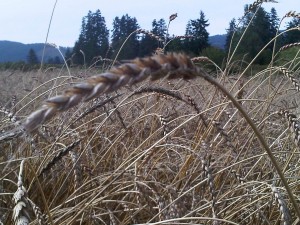 Brock and Heather had planted three grains this year — some of which had been planted last fall, and some of which were planted in the spring. It was interesting to see the differences between the same varieties planted at different times of the year. Many of the grains are quite happy being fall-planted, and there was a marked difference in the rye which Brock had not only planted in the fall, but interspersed with fava beans!
Brock and Heather had planted three grains this year — some of which had been planted last fall, and some of which were planted in the spring. It was interesting to see the differences between the same varieties planted at different times of the year. Many of the grains are quite happy being fall-planted, and there was a marked difference in the rye which Brock had not only planted in the fall, but interspersed with fava beans!
The Red Fife wheat is a heritage variety, which, while good for baking (excellent flavour and protein content), runs the risk of lodging (falling over). The stalks are decidedly more slender. For the drawbacks though, for those planting and harvesting on a smaller scale, this was much easier to load into the trucks, compacted more easily, and did not have much in the way of prickly awns.
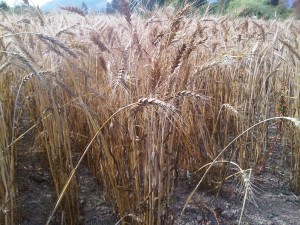 The Hard White Spring wheat, on the other hand, is much more compact, with sturdy stems and lots of protection from marauding fauna due to the awns. While it cut very easily, it took a great deal more effort to pack the trucks for their trip to the combine, and I`m still picking prickly bits of awns out of my underwear!!!!
The Hard White Spring wheat, on the other hand, is much more compact, with sturdy stems and lots of protection from marauding fauna due to the awns. While it cut very easily, it took a great deal more effort to pack the trucks for their trip to the combine, and I`m still picking prickly bits of awns out of my underwear!!!!
Finally, the Rye turned out to be very prolific. Some of the seedheads were a full 4-5 inches long!!! The stems of the rye that Brock planted with the fava beans were easily 6 feet tall, and actually got harvested by the Cowichan Valley Ecovillage to use as thatching for some of their demonstration buildings. These guys were harvesting fairly carefully, creating nice neat bundles as they went. Despite being so tall the stems were remarkably sturdy, showing little sign of toppling over. The rye (similar to barley), also has a built-in indicator of ripeness, where the seed-head nods so its parallel with the stem, curling right back on itself as it dries.
During the course of the day, we harvested all of the grain by hand — a combination of scythe, sickle and shears — creating piles as we went. The harvest went fairly quickly, and was loaded into the waiting trucks in batches (to keep each grain separate) to be taken off to the combine. It is possible to thresh by hand, but the combine was MUCH faster!
At the combine, the grain got fed into the combine with a fork — through the rotating drum, with the straw coming out the back end. A couple of people at the back end were needed to feed the straw into the baling machine, which resulted in a good number of bales of organic straw for Heather and Brock to use in the fields.
Finally, the grain, once threshed, was collected in plastic bins — you can see Brock, hoisted up near the chute, making sure the rye actually got into the bins!
All told, we had 12-15 folks helping throughout the day — most of whom, like me, were inexperienced at this kind of thing. Total harvest, about 900 lbs of grain, with a bit left on the ground to fatten up the chickens!
For my share, I now have 10 lbs Red Fife, 10 lbs Hard White Spring wheat and 20 lbs Rye. I`ll be making bread with some, using some as whole grain (wheat or rye berries), and perhaps saving a little for seed for next year. I`m already looking forward to next year!
3 Responses to Bringing in the sheaves …
Leave a Reply Cancel reply
My latest Tweets
- @YukariP reviews of the single serve models show nespresso the best. too much plastic for me, plus i want to brew my own choice of coffee!
- Great fact sheets from Utah State U on preserving different foods -- http://ht.ly/5ZsiA #canning #canvolution
- RT @familyfeedbag: A couple of #yyj food bloggers are getting together for a drink @canoebrewpub on Sun, Aug 28 at 8pm. Wanna join us?
- @gdgeek @kevwrites ... a leotard worse than this? http://www.youtube.com/watch?v=J1c2KzJbcGA
- its a fine line, isn't it! RT @tavissmiley: What's happening in London could happen here. It's time to end #poverty now.

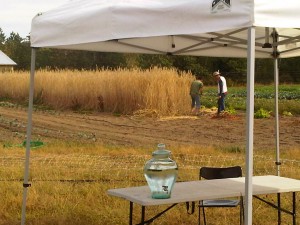
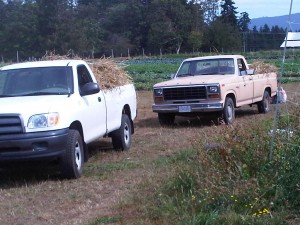
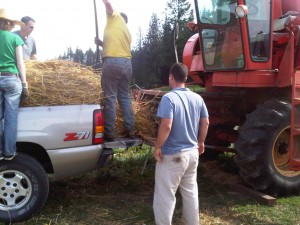
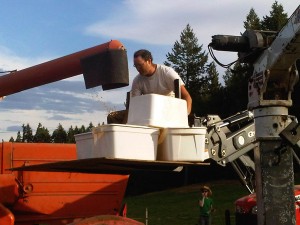













[...] This post was mentioned on Twitter by Janice Mansfield, Janice Mansfield. Janice Mansfield said: Bringing in the sheaves (or how I spent my Sunday) http://ht.ly/2xCHn [...]
Thanks for this interesting post! It looks like you had a great day — there’s nothing like collecting your own food for satisfaction…I’m glad to have found your blog — I’m on Pender Island and also have a Shiba named Koda. Theresa
Thanks for stopping by Theresa. Always great to meet fellow shiba inu owners!